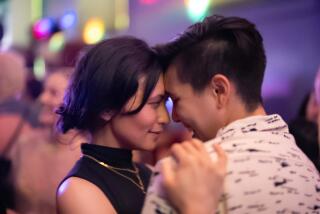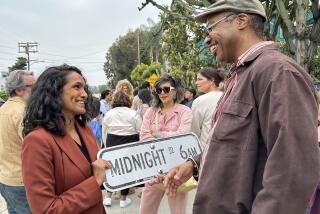The Babadook as an LGBT icon makes sense. No, really
This yearâs LGBTQ Pride Month has found an unlikely mascot: The Babadook.
Yes. The top-hat-wearing, pop-up-book-writing demonic figure from the eponymous 2014 Australian indie thriller.
It started as an apparent error on Netflix. A Tumblr user who has since deleted their blog posted a screenshot of the streaming companyâs âLGBT Moviesâ page. Prominently featured: âThe Babadook.â
From there, it became a running gag to insist the Babadook was gay.
June is LGBTQ Pride Month. As people geared up to celebrate, they started making and sharing fan art.
It began as a joke but, in the greater context of the Babadook himself, LGBT history and so-called gay icons, it actually makes sense.
âSomeone was like, âHow could âThe Babadookâ become a gay film,â and the answer was readily available,â said Karen Tongson, an associate professor of gender studies and English at USC. âHe lives in a basement, heâs weird and flamboyant, heâs living adjacently to a single mother in this kind of queer kinship structure.â
The Babadook is creative (remember the pop-up book) and a distinctive dresser. Instead of living in a proverbial closet, he lives in a literal basement. He exists in a half-acknowledged state by the other people in his house. The family is afraid of what he is, but finds a way to accept him over time.
âFor many LGBT people, thatâs what it feels like to be in your own families sometimes,â Tongson said.
Naturally, there are counter-arguments: The Babadook never says heâs gay. He never displays physical attraction to another person. But historically, fictional characters havenât needed to say âI am gayâ out loud to be read as gay or to become gay icons.
âSo many LGBT people have been barred from seeing themselves represented in popular culture, so weâve had to project ourselves into so many of these figures,â Tongson said. âThere are ways to read into the character itself and the structure of how this ostensibly monstrous thing becomes incorporated ultimately into a family.â
Michael Bronski is the author of several books about LGBTQ culture and history, including âA Queer History of the United Statesâ and âCulture Clash: The Making of Gay Sensibility.â Heâs also a professor in the studies of women, gender and sexuality department at Harvard.
In terms of gay icons, he said, the community has adopted plenty of people who werenât openly gay or gay at all. In the 1950s, it was Judy Garland. Her place in gay culture was so well-known that referencing her out loud became a code word to indicate that you were part of it, Bronski said: You might ask another man, âAre you a friend of Judyâs?â
In the 1960s, it was Barbra Streisand, who unapologetically embraced both her gay fans and her Jewish identity. âShe was proud of who she was,â Bronski said. In the â70s, it was Bette Midler and Cher, then Madonna in the â0s and â90s, and Lady Gaga in the 2000s.
And now, the Babadook.
In this moment, who better than the Babadook to represent not only queer desire, but queer antagonism, queer in-your-faceness, queer queerness?
— Michael Bronski
Bronski said a longstanding connection exists between the horror/fantasy genres and queerness. Frankenstein has been read as an allegory for a gay man, hunted down and ostracized by his community for who he is. The Phantom of the Opera hides both himself and his forbidden, unrequitable love. In a popular 19th century novel that predated Bram Stokerâs âDracula,â both the vampire and the victim were women.
Modern horror and fantasy have continued the tradition: In the second âNightmare on Elm Streetâ movie, Freddy Krueger â who was murdered by parents for being a child molester, a crime that has been conflated with gayness â appears in the shower with a naked teen boy in what Bronski sarcastically called a âcompletely not-coded gay subplot.â
In 2003, Bronski says he caught flak from a British tabloid for writing an article about the queer allegories in the âHarry Potterâ books â in particular, how Harry Potter lives in the closet and has to hide who he is because his family disapproves. Oh, and the name of school he was going to be sent to: Stonewall High.
At the very first official gay pride parade, in New York City in 1970, activist Donna Gottschalk held up a sign: âI am your worst fear, I am your best fantasy.â
Referencing the sign, Bronski said itâs still at least partly true: âIn some way, gay people, queer people, are the worst fear for heterosexuals, as well as on some level, the best fantasy â the sheer pleasure of not being on the inside, of not having to control everything you do and think and say to fit norms.â
Bronski said the sign, and the embrace of the Babadook, represent âa sort of queer affiliation to monsters.â Tongson, the USC professor, agreed: For âpeople who lived with a lot of their love and their passion in the closet, or who felt demonized in the broader culture, itâs very easy to find points of identification with monsters.â
And in the current political climate, when many LGBTQ people feel their rights are under attack, embracing a literal demon can feel like a way of reclaiming power and agency.
âIn this moment, who better than the Babadook to represent not only queer desire, but queer antagonism, queer in-your-faceness, queer queerness?â Bronski said.
âThe Babadookâ is still streaming on Netflix, though itâs no longer categorized in the âGay & Lesbianâ section. As to whether the Babadook himself actually identifies as LGBTQ, the closest thing to an answer comes courtesy of the filmâs official Facebook page, which weighed in after someone criticized adding the rainbow overlay to the profile photo.
Follow me on Twitter @jessica_roy.
ALSO
How these neon signs tell the history of LGBT performers in Vegas
Donna Karan, Prabal Gurung and Phillip Lim attend LGBT Centerâs annual fashion dinner in New York
Opinion: Generations of LGBT activists blazed the trail for Caitlyn Jenner
More to Read
Only good movies
Get the Indie Focus newsletter, Mark Olsen's weekly guide to the world of cinema.
You may occasionally receive promotional content from the Los Angeles Times.











